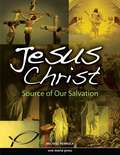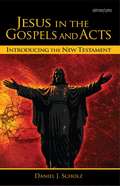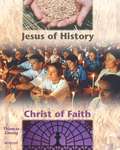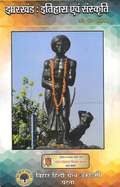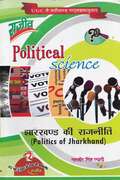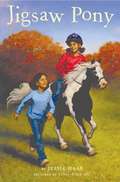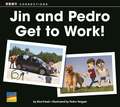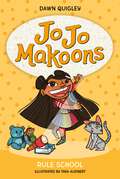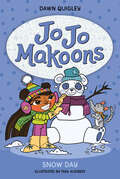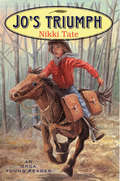- Table View
- List View
Jesus Christ: Source of Our Salvation
by Michael PennockThe Paschal Mystery of Christ's Cross and Resurrection stand at the center of the Good News. In "Jesus Christ: Source of Our Salvation," students learn in greater depth the saving actions of the Lord. More than a survey of the events of Salvation History, this text unpacks the meaning of God's sacred and mysterious plan from creation, to the consequences and promises of Original Sin, through his compassionate and loving care culminating in the life, Passion, Death, and Resurrection of Jesus Christ. Written in accord with Course III of the U. S. Bishops' doctrinal framework, this text will be published in advance of the Fall 2011 term. This textbook has been developed for course three of the Doctrinal Elements of a Curriculum Framework from the United States Conference of Catholic Bishops. (c. 2010) This text has been found in conformity with the "Catechism of the Catholic Church. . "
Jesus In The Gospels And Acts: Introducing The New Testament
by Daniel J. ScholzEngaging, scholarly, and theologically honest, this introductory textbook will be welcomed by students and professors alike. What do we really know about Jesus and how do we know it? Jesus in the Gospels and Acts: Introducing the New Testament explores these questions from the perspective of the New Testament--specifically the four Gospels and the Acts of the Apostles, as well as the extracanonical gospels. Using language and concepts considerate of a religiously diverse undergraduate audience, the author explores issues of authorship, historicity, culture, and theology. Features include: "Check Your Reading" questions check the students' basic comprehension. "Do You Have the Basics?" puzzles check for comprehension through crosswords, word finds, sequencing, and matching activities. "Questions for Reflection" challenge the students to think more deeply about the reading's meaning and the implications for us today. "This book focuses on the central figure of the Christian Scriptures: Jesus. Arguably, no other figure in history has had more influence in shaping many of the religious and cultural norms in the world today. Whether you belong to a specific faith tradition or none at all, possessing a working knowledge of Jesus and the Gospels is important for religious, historical, and cultural literacy. " --from the author's introduction
Jesus Our Guide: Faith & Life Series (Third Edition)
by Ignatius PressThe aim of the book is to help the fourth graders to learn the purpose of life through the scriptures as it puts into use the four principal parts of catechisms: the Commandments, the Creed, the Prayer and Scripture, Sacraments and Liturgy
Jesus of History: Christ of Faith (3rd Edition)
by Thomas ZanzigWho is Jesus Christ, really? What was his life about? Our thorough, full-color revision of the popular Jesus of History, Christ of Faith invites students to explore the life of Jesus through a Christological study of the New Testament. The student text for ninth and tenth graders first considers the New Testament as a whole, particularly the Gospels, and explains the Jewish historical, religious, and cultural world into which Jesus was born. Using the Gospels as the primary source, the text explores Jesus' birth, early life, and ministry; then it focuses on the scriptural accounts of his death, the Resurrection, the Ascension, and Pentecost, and on their central significance for the Church's understanding of Jesus as the Christ, the Son of God. Award: Jesus of History, Christ of Faith won the 1999 Certificate of Merit for the Premier Print Award from the Printing Industries of America. Chosen from thousands of entries, the Premier Print Award goes to those firms who demonstrate a unique ability to create visual masterpieces.
Jesus: The Way, The Truth, and The Life (Grade #7)
by Sisters of Notre DameWritten by the Sisters of Notre Dame, the new 2009 edition of Christ Our Life, grades 1-8, continues to provide the thorough foundation of our Catholic faith that the series has been known for. In this new edition we've paid special attention to helping children turn their learned faith into a lived faith. Program features Original spiral curriculum ensures consistent progress and development Faith content is developed throughout with Scripture integrated into each lesson Four pillars of the Church-Creed, Sacraments, Commandments, and Prayer-are integrated Abundant prayer opportunities invite personal and communal prayer Catholic Social Teaching connects with real-life faith A copy of the Catholic Prayer for Catholic Families is included with each Student Book allowing parents the convenience of having traditional prayers and suggestions for everyday prayer in one handy book. Christ Our Life is found to be in conformity with the Catechism of the Catholic Church. View samples: http://www.loyola press.com/christ-our-life-2009-view-online-samples.htm
Jewels for a Princess (Step into Reading)
by Ruth HombergJoin Ariel, Cinderella, Tiana, Rapunzel, Aurora, and Jasmine as they share their most dazzling jewels and gems—and learn that friendship is the most precious treasure of all. This Step 2 reader starring the Disney Princesses will be a favorite among children ages 4-6. Step 2 readers use basic vocabulary and short sentences to tell simple stories. For children who recognize familiar words and can sound out new words with help.
Jewish Passages: Cycles of Jewish Life
by Harvey E. GoldbergThis book is both comprehensive and accessible, making Jewish customs meaningful even to non-specialists. A scholarly achievement with tremendous value for anyone in Jewish Studies including rabbis and members of synagogue study groups.
Jharkhand Itihas Evam Sanskruti M.A. SEM-II Ranchi University, N.P.U: झारखंड इतिहास एवं संस्कृति एम.ए. सेमीस्टर-II राँची यूनिवर्सिटी, एन.पी.यू.
by B. Virottamप्रस्तुत ग्रंथ “झारखंड : इतिहास एवं संस्कृति", डॉ. बी. वीरोक्तम, द्वारा लिखित है, जो भारत सरकार के मानव संसाधन विकास मंत्रालय (शिक्षा-विभाग) के शत-प्रतिशत अनुदान से बिहार हिंदी ग्रन्थ अकादमी द्वारा सप्तम् संस्करण के रूप में प्रकाशित किया जा रहा है। इस पाठपुस्तक में तेराह अध्याय दिये गये है, जिसमे हर अध्याय के विवरण कि व्याख्या कि गई है । यह ग्रंथ इतिहास विषय के स्नातक एवं स्नातकोत्तर कक्षाओं के विद्यार्थियों के लिए उपयोगी सिद्ध होगा।
Jharkhand Ki Rajneeti M.A. - Kolhan University Chaibasa, Jharkhand: झारखण्ड की राजनीति एम. ए. – कोल्हान विश्वविद्यालय चाईबासा, झारखंड
by Rashmi Sharma Prof. Mahabir Singh Tyagiविश्वविद्यालय अनुदान आयोग (UGC) द्वारा प्रदत्त मॉडल पाठ्यक्रमानुसार Choice Based Credit सेमेस्टर प्रणाली (CBCS) पर आधारित लोकप्रिय तथा छात्रोपयोगी पुस्तक है। झारखण्ड की राजनीति यह पुस्तक कोल्हान विश्वविद्यालय, चाईबासा झारखंड की एम. ए. की कक्षाओं के नवीनतम् पाठ्यक्रमानुसार लघु उत्तरीय तथा वस्तुनिष्ठ प्रश्नोत्तर सहित है। इस पुस्तक में सम्पूर्ण नवीनतम् पाठ्यक्रम, गत वर्षों के सोल्वड पेपर्स, सरल प्रश्नोत्तर रूप और अधुनातम् क्रमबद्ध विषय-सामग्री दी गई है।
Jharkhand Update (Samagra Jankari Ek Nazar Me)
by Baidhnath Upadhyayस्पर्धा प्रकाशन जमशेदपुर, झारखण्ड के द्वारा इस पुस्तक के संशोधित तथा संवर्द्धित संस्करण को पूर्णतः समसामयिक करते हुए ‘झारखण्ड अपडेट (समग्र जानकारी : एक नजर में)’ नाम से हिन्दी पुस्तक लिखी हैं। झारखण्ड के बारे में सारी सूचनाएं एक पुस्तक में संग्रहित करके और झारखण्ड की धरती पर छिपे हुए अनेक धरोहरें अभ्यर्थियों के सामने प्रस्तुत करता है। विभिन्न प्रतियोगिता परीक्षाओं हेतु झारखण्ड राज्य से संबंधित सम्पूर्ण तथ्य संदर्भ में सम्पन्न परीक्षाओं में झारखण्ड से पूछे गये लगभग सभी प्रश्नों के उत्तर इस पुस्तक में समाहित है। यही कारण है कि प्रतियोगिता परीक्षाओं के अभ्यर्थियों को इसका समुचित लाभ प्राप्त हो सके। पाठकों के सुझावों के अनुरूप इसे और अधिक ज्ञानवर्द्धक एवं परीक्षोपयोगी बनाने का प्रयास किया गया है।
Jigsaw Pony
by Jessie Haas Ying-Hwa HuThe only thing twins Fran and Kiera have ever agreed on is that it would be wonderful to own a pony -- a pony they could gallop and leap over jumps.<P> One day their father brings them Jigsaw, a Shetland pony who needs a new family. Jigsaw is the perfect pony. He can do anything -- even fit himself into Dad's station wagon for the ride home.<P> But with Jigsaw comes trouble. The more Fran and Kiera like something, the harder it is for them to share. And they love Jigsaw. Worse, Jigsaw won't gallop far and he won't leap more than a couple of jumps. Is something wrong with the way the twins ride? Or is something wrong with Jigsaw?
Jilly Flurb's Best Smile (Fountas & Pinnell Classroom, Guided Reading)
by Leo Broadley Dale-Marie BryanNIMAC-sourced textbook
Jilly Flurb's Big ChaHOO! (Fountas & Pinnell Classroom, Guided Reading Grade 3)
by Leo Broadley Dale-Marie BryanNIMAC-sourced textbook
Jim White's Discovery (Fountas & Pinnell Classroom, Guided Reading Grade 4)
by Barbara Seuling Greg NewboldNIMAC-sourced textbook
Jimmy's Room (Fountas & Pinnell Classroom, Guided Reading)
by Sally Comport Nathaniel ClintonNIMAC-sourced textbook. INSIDE THE ROOM. When Jimmy turns thirteen, his uncle gives him a key to a room and orders him to lock himself in before the sun sets. Should Jimmy obey—or should he listen to the doubts inside his head?
Jin and Pedro Get to Work!
by Cindy Peattie Kira Freed Pedro VerganiJin and Pedro want to buy a new basketball. What jobs will the boys try to get? Will they earn enough money?
Jivanavedha TY BA. Pune University
by Shirish Landage Snehal TavareJivanavedha Marathi text book for Third year from The Pune University in Marathi.
Jo Jo Makoons: Fancy Pants (Jo Jo #2)
by Dawn QuigleyFilled with lots of glitter, raised pinkies, and humorous misunderstandings, this second book in the Jo Jo Makoons series—written by Dawn Quigley and illustrated by Tara Audibert—is filled with the joy of a young Ojibwe girl discovering her very own special shine from the inside out. First grader Jo Jo Makoons knows how to do a lot of things, like how to play jump rope, how to hide her peas in her milk, and how to be helpful in her classroom. But there’s one thing Jo Jo doesn’t know how to do: be fancy. She has a lot to learn before her Aunt Annie’s wedding! Favorite purple unicorn notebook in hand, Jo Jo starts exploring her Ojibwe community to find ways to be fancy. The Heartdrum imprint centers a wide range of intertribal voices, visions, and stories while welcoming all young readers, with an emphasis on the present and future of Indian Country and on the strength of young Native heroes. In partnership with We Need Diverse Books.
Jo Jo Makoons: Rule School (Jo Jo #4)
by Dawn QuigleyIt is good to follow the rules. But there are just so many! In this fourth book in the beloved Jo Jo Makoons chapter book series, Jo Jo’s talents may not quite include following her substitute teacher’s rules… Jo Jo and her classmates are excited that the Elders’ Tribal Center has changed the rules for the talent show to invite the whole tribe to perform. But the rules have also changed in Jo Jo’s classroom, where instead of their teacher, they have a substitute. Since Jo Jo has a knack for being helpful, she puts her mind to helping her classmates decide on their talents—but can she manage to follow the substitute teacher’s rules?Even if no one else quite understands Jo Jo’s own rules (like that saying “please” makes words softer and fluffier to hear and that square foods are too pointy to be yummy), her undeniable talents for celebrating, curiosity, and class keep her happily hop-skipping in step with her Ojibwe community.The first book in this acclaimed chapter book series was an American Indian Youth Literature Award Honor Book; a best book of the year from Kirkus Reviews, School Library Journal, American Indians in Children's Literature, and the Chicago Public Library; a Charlotte Huck Award Honor Book; and a Cooperative Children's Book Center CCBC Choices selection.
Jo Jo Makoons: Snow Day (Jo Jo #3)
by Dawn QuigleyOh, snow day, snow day, what a very fun no-school day! Jo Jo Makoons is back in the third book in this favorite chapter book series, and she’s planning the very best version of the winter Olympics that her Ojibwe community has ever seen…Jo Jo Makoons has noticed that the family members she loves most—Mama, Kokum, and even her cat, Mimi—all have their own ways of being healthy. So when Teacher says that their class will be learning about healthy habits, Jo Jo is ready to be neighborly by helping everyone around her be healthy too.After a snowstorm shuts down her Ojibwe reservation, Jo Jo uses her big imagination and big personality to help both Elders and classmates alike. Because after all, being healthy means being together!With her signature heart and hilarity, in this third book in her chapter book series, Jo Jo Makoons shows care for her community as only this vibrant young girl can. The first book in this acclaimed chapter book series was an American Indian Youth Literature Award Honor Book; a best book of the year from Kirkus Reviews, School Library Journal, American Indians in Children's Literature, and the Chicago Public Library; a Charlotte Huck Award Honor Book; and a Cooperative Children's Book Center CCBC Choices selection.
Jo Jo Makoons: The Used-to-Be Best Friend (Jo Jo #1)
by Dawn QuigleyJo Jo Makoons has descriptive copy which is not yet available from the Publisher.
Jo's Triumph (Orca Young Readers)
by Nikki TateIn the late 1850s in and around Carson City, struggles between the Indians and the local whites are growing. During the struggles, Joselyn, a young orphan, meets Sarah Winnemucca, a Paiute girl who becomes her friend and gives her some valuable advice. When Joselyn takes that advice and escapes from the Carson City Home for Unfortunate Children, she has no idea that her boy's disguise and her love for and expertise with horses will lead her straight to the Pony Express. Joselyn becomes Jo and turns to a life that demands all her inner strength and resources. Then the meanest man on the route learns her secret and uses it to extract a promise that kept or broken could mean death.
